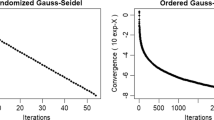Abstract
The best linear unbiased prediction (BLUP), derived from the linear mixed model (LMM), has been popularly used to estimate animal and plant breeding values (BVs) for a few decades. Conventional BLUP has a constraint that BVs are estimated from the assumed covariance among unknown BVs, namely conventional BLUP assumes that its covariance matrix is a \( \lambda K \), in which \( \lambda \) is a coefficient that leads to the minimum mean square error of the LMM, and \( K \) is a genetic relationship matrix. The uncertainty regarding the use of \( \lambda K \) in conventional BLUP was recognized by past studies, but it has not been sufficiently investigated. This study was motivated to answer the following question: is it indeed reasonable to use a \( \lambda K \) in conventional BLUP? The mathematical investigation concluded: (i) the use of a \( \lambda K \) in conventional BLUP biases the estimated BVs, and (ii) the objective BLUP, mathematically derived from the LMM, has the same representation as the least squares.


Similar content being viewed by others
References
Bauer A. M., Reetz T. C. and Léon J. 2006 Estimation of breeding values of inbred lines using best linear unbiased prediction (BLUP) and genetic similarities. Crop Sci. 46, 2685–2691.
Belonsky G. M. and Kennedy B. W. 1988 Selection on individual phenotype and best linear unbiased predictor of breeding value in a closed swine herd. J. Anim. Sci. 66, 1124–1131.
Blasco A. 2001 The Bayesian controversy in animal breeding. J. Anim. Sci. 79, 2023–2046.
Choi T., Lim D., Park B., Sharma A., Kim J.-J., Kim S. et al. 2017 Accuracy of genomic breeding value prediction for intramuscular fat using different genomic relationship matrices in Hanwoo (Korean cattle). Asian-Australas J. Anim. Sci. 30, 907–911.
Emik L. O. and Terrill C. E. 1949 Systematic procedures for calculating inbreeding coefficients. J. Hered. 40, 51–55.
Hadfield J. D., Wilson A. J., Garant, D., Sheldon B. C. and Kruuk L. E. B. 2010 The misuse of BLUP in ecology and evolution. Am. Nat. 175, 116–125.
Henderson C. R. 1975 Best Linear unbiased estimation and prediction under a selection model. Biometrics 31, 423–447.
Henderson C. R., Kempthorne O., Searle S. R. and von Krosigk C.M. 1959 The estimation of environmental and genetic trends from records subject to culling. Biometrics 15, 192–218.
Kim B. and Beavis W. D. 2017 Numericware i: Identical by State Matrix Calculator. Evol. Bioinform. 13, 1176934316688663 (online).
Kim B., Beavis W. D. and Léon J. 2016 Numericware N: Numerator Relationship Matrix Calculator. J. Hered. 107, 686–690.
Kim B., Dai X., Zhang W., Zhuang Z., Sanchez D. L., Lübberstedt T. et al. 2019 GWASpro: a high-performance genome-wide association analysis server. Bioinformatics 35, 2512–2514.
Manzanilla-Pech C. I. V., Veerkamp R. F., de Haas Y., Calus M. P. L. and Ten Napel J. 2017 Accuracies of breeding values for dry matter intake using nongenotyped animals and predictor traits in different lactations. J. Dairy Sci. 100, 9103–9114.
Meuwissen T. H. E., Hayes B. J. and Goddard M. E. 2001 Prediction of total genetic value using genome-wide dense marker maps. Genetics 157, 1819–1829.
Nielsen H. M., Sonesson A. K. and Meuwissen T. H. E. 2011 Optimum contribution selection using traditional best linear unbiased prediction and genomic breeding values in aquaculture breeding schemes. J. Anim. Sci. 89, 630–638.
Panter D. and Allen F. L. 1995a Using best linear unbiased predictions to enhance breeding for yield in soybean. II: Selection of superior crosses from a limited number of yield trials. Crop Sci. 35, 405–410.
Panter D. M., Allen F. L. 1995b Using best linear unbiased predictions to enhance breeding for yield in soybean: I. choosing parents. Crop Sci. 35, 397–405.
Piepho H.-P. 1994 Best linear unbiased prediction (BLUP) for regional yield trials: a comparison to additive main effects and multiplicative interaction (AMMI) analysis. Theor. Appl. Genet. 89, 647–654.
Postma E. 2006 Implications of the difference between true and predicted breeding values for the study of natural selection and micro-evolution. J.Evol. Biol. 19, 309–320.
Robinson G. K. 1991 That BLUP is a good thing: the estimation of random effects. Statist. Sci. 6, 15–32.
Spindel J., Begum H., Akdemir D., Virk P., Collard B., Redoña E. et al. 2015 Genomic selection and association mapping in rice (Oryza sativa): effect of trait genetic architecture, training population composition, marker number and statistical model on accuracy of rice genomic selection in elite, tropical rice breeding lines. PLOS Genet. 11, e1004982.
VanRaden P. M. 2008 Efficient methods to compute genomic predictions. J. Dairy Sci. 91, 4414–4423.
Author information
Authors and Affiliations
Corresponding author
Additional information
Corresponding editor: H. A. Ranganath
Rights and permissions
About this article
Cite this article
Kim, B. The use of a genetic relationship matrix biases the best linear unbiased prediction. J Genet 99, 75 (2020). https://doi.org/10.1007/s12041-020-01220-y
Received:
Revised:
Accepted:
Published:
DOI: https://doi.org/10.1007/s12041-020-01220-y



